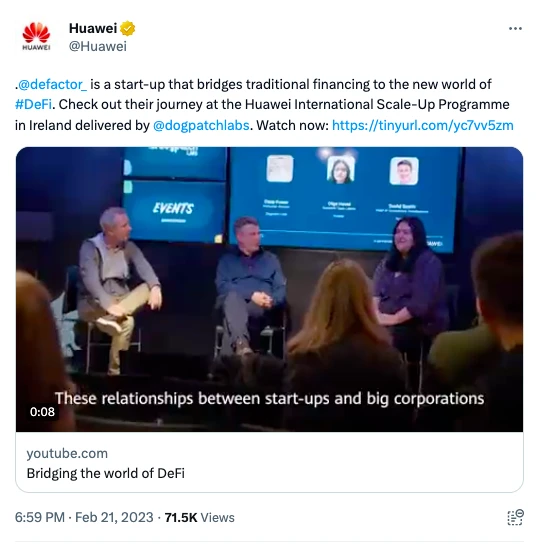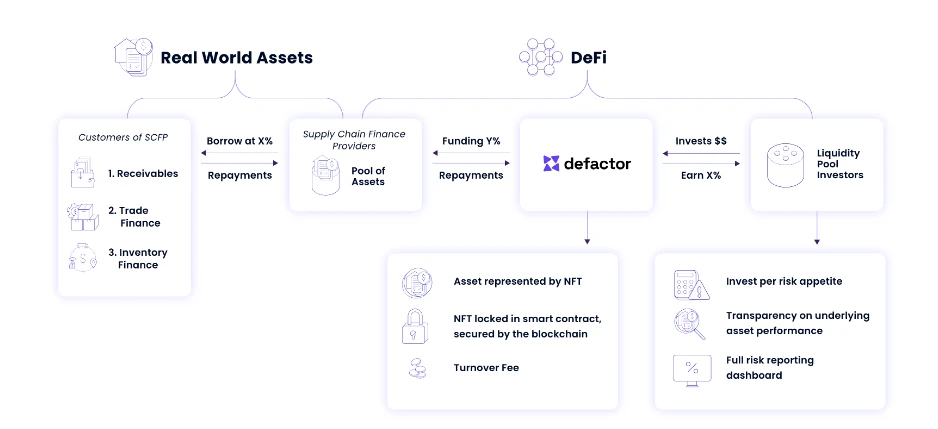What exactly does Huawei's "Defactor" do?
Written by: Qin Xiaofeng, ODAILY Planet Daily
This afternoon, the crypto community widely circulated a screenshot, along with the message ------ "Huawei's official Twitter recommended a DeFi project called 'Defactor'." As soon as the news broke, Defactor's governance token FACTR surged, currently reported at $0.214, with a maximum increase of about 800%.
The author confirmed the reliability of the news after verification. The tweet was posted on February 21 by Huawei's official Twitter, which also included an interview video featuring the CEO of Defactor.

"Defactor is a startup that connects traditional financing with the new world of DeFi."
According to the video (click to jump), Huawei previously held the "Huawei International Scale-Up Programme" in Ireland in collaboration with Dogpatch Labs, with Defactor participating as a local Web3 startup in this support program. Odaily Planet Daily also discovered that the program was held as early as last October, with nine other companies including: Empeal, Tracworx, Little Red Edu, Helgen, Graphite Note LTD, Halosos, Energy Elephant, Xpanse AI, Sensipass.
What kind of platform is Defactor? According to the official website (https://defactor.com/), its core concept is the tokenization of real-world assets (RWA), with competitors in this space including Centrifuge, MakerDAO, etc. "The 'real world' is becoming digital. Ownership is no longer proven by documents. We aim to eliminate friction for people, businesses, and their assets, providing opportunities. We bridge the gap between traditional (TradFi) and decentralized (DeFi) finance."
In simple terms, Defactor connects asset originators (AO) on one end and liquidity providers (LP) on the other, creating a DeFi investment platform using blockchain tools, with a business model that charges fees to both AOs and LPs.

Specifically, asset originators (AOs) need to apply on Defactor, submitting relevant legal documents to prove the reliability of the assets; Defactor evaluates the assets through a risk control system and auditing, providing four ratings: Prime+, Prime, Prime-, SubPrime.
Users interested in becoming investors providing liquidity funds also need to comply with the platform's KYC and AML requirements; they will then be assigned a dashboard where LPs can allocate funds to selected liquidity pools (with different risk profiles), supporting crypto payments.
Currently, Defactor only supports three types of real-world asset tokenization, which are:
Accounts receivable/factoring* (Note: Factoring, also known as accounts receivable purchase or collection and payment) *;
Trade financing;
Inventory financing.
Regarding tokens, FACTR is the native token of the Defactor ecosystem, with the following application scenarios:
Network access: Asset originators need FACTR tokens to access Defactor's platform and services. AOs' tokens will be locked in smart contracts for the duration of the financing period, thereby reducing circulation. AOs may need to pay fees for each funding period.
Governance: In the medium term, FACTR will introduce a governance model to manage and optimize the network, allowing token holders to participate in community decision-making.
Staking: Token holders who stake FACTR will receive rewards.
Buyback model: Defactor will allocate a portion of its revenue to regularly buy back FACTR tokens.
Currently, Defactor is still in the early stages of development and has not disclosed any business data. The author reminds users to participate cautiously and avoid FOMO.










